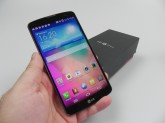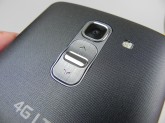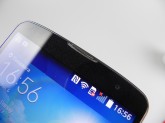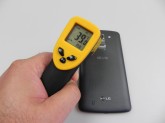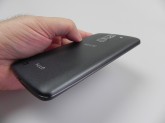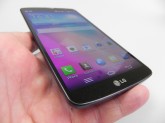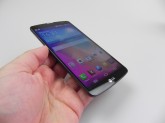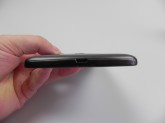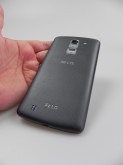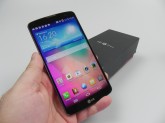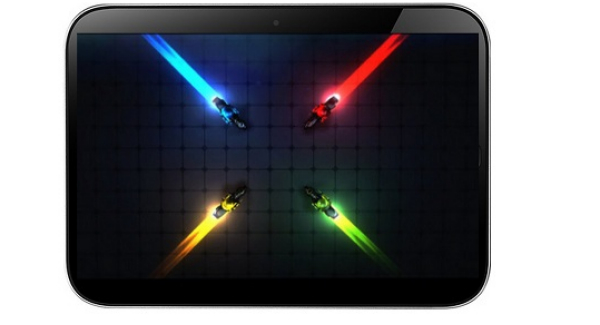LG G Pro 2 is a 5.9 inch phablet that’s considered a Samsung Galaxy Note 3 rival and this model was announced back in February and launched in April. It has been nicknamed the “LG G Flex without the Flex”, because of its big diagonal. Priced at $650 on Amazon, this model feels like a larger LG G2, with whom it shares a few specs actually.
The design involves an 8.3 mm thickness and this model weighs 172 grams. It has a larger screen compared to the predecessor, that had a 5.5 incher. There are still buttons at the back, the physical On/Off and volume buttons, that are quickly becoming standard for the top notch LGs. There’s a good and grippy back texture, that’s dotted and feels nice to the user’s hand. We’ve got small screen bezels and once you remove the back cover (done easily actually), you’ll notice under it the microSD card slot, the micro SIM and the battery.
At the front of the device, we find an area covered with a sort of glitter material, that’s best seen on the sides and at the top and bottom of the handset. Then we’ve got the earpiece, front camera and sensors, also upfront. At the back we find the main camera, physical buttons, with an On/Off button that lights up, the flash and speakers. At the top of the LG G Pro 2 we’ve got the audio jack, infrared emitter and a microphone.
At the bottom there’s the microUSB port, another microphone and moving on to the sides, there’s nothing there, since the buttons are at the back. This smartphone has a slightly curved profile and sits quite well in the user’s hand. The case is made of a polycarbonate material and there’s a 77.2% screen to surface ratio, that’s quite good. Finally, I find the design to be more appealing here than the one of the Galaxy Note 3, but that’s a personal opinion.
On the hardware side, we’ve got a 5.9 inch display, a True IPS+ LCD with Full HD resolution and Gorilla Glass protection. The CPU inside this model is a quad core Snapdragon 800 clocked at 2.26 GHz, with Krait 400 cores. The GPU is an Adreno 330 and we also get 3 GB of RAM, 16/32 GB of storage and a microSD card slot with support for up to 64 GB extra. The back camera is a 13 megapixel unit, while the front one is a 2.1 MP shooter.
We’ve got active noise canceling and on the connectivity side there’s quad band GSM/GPRS/EDGE, HSPA 42.2 Mbps connectivity (download speed), LTE, microUSB 2.0 with USB Host, USB On the Go and Slimport. LG G Pro 2 supports Bluetooth 4.0, infrared, NFC, WiFi, WiFi Direct, DLNA, GPS and Glonass. There’s an accelerometer here, a proximity sensor and a 3200 mah battery (Li-Ion). On paper this device should offer 370 hours of standby time and 14 hours of talk time.
By the way, the SAR value is 0.30 W/kg. In our usual video playback test, that involves a looped video played with WiFi on and brightness at 50% we achieved only 5 hours and 20 minutes of video playback, which is very weak. We did a get and a half of normal usage though. The charging is very OK: one hour and 47 minutes. I should probably mention that this phone is a test unit and the battery low usage time may be an unique situation here.
There’s also a Battery Saver option here, that allows you to select which features to turn off at a certain battery level. There’s Auto Sync, WiFi, Bluetooth, vibrate and you can also set up timeout values and brightness levels. As fa as audio goes, LG claims that this model offers 30% more volume than the predecessor. The speaker is similar to the one on the LG G Flex and the audio player is organized in songs, albums, artists, folders, nearby and cloud. This player supports FLAC and WAV files and also offers a YouTube shortcut.
The equalizer offers options like Pure Sound, Normal, Bass Reducer, Bass Booster, Vocal Booster, Treble Booster and Custom, that allows you to play with a variety of hertz settings. You can also tweak the pitch and speed of the song. The speaker offers a clear sound, a loud experience and a good bass, plus a warm voice. The speaker tends to lose a bit of strength when placed on a flat surface. Overall the acoustics are nice and you get 82.4 decibels at the front and 85.7 decibels at the back.
The headphones bundled here are tangle free and they’re the Quad Beats kinds, if I’m not mistaking. The headphones are loud, offer very good bass, they’re clear and comfy. The remote has 3 buttons and LG claims that this model comes with HiFi sound and studio quality. We move on to the video aspect, where we find a pretty capable player, that supports pinch to zoom and Q Slide, which is basically a floating window on top of other apps, allowing you to watch vids and do other things.
Other options offered by this video player include share, screenshot, subtitles, play speed, brightness and smart video. There are 3 crop modes and support for DivX and AC3 among others. The screen is a True IPS+ LCD with a Full HD resolution and 373 ppi. It’s both bright and crisp, plus it offers good contrast, wide view angles, but also not exactly realistic colors. The pixels are of the RGB Stripe kind and the lux level is 357 lux units on a white background. This is below the Note 3, that gets 400 lux units and below the Xperia Z2 and its 366 lux units. I would say that the screen is bright enough, an accurate description of its performance. Overall this is a good screen and if you enter the Settings area in the Display section you’ll find options for the lockscreen, homescreen, front touch buttons combo and font type plus size.
There’s also a Smart Screen option, that keeps the screen on when your face is detected and the Smart Video option, that pauses the video when your face is not detected. We’ve got notification LED settings, both the front and back one. Finally, we move on to the camera, a 13 megapixel shooter with optical stabilization plus, which is basically the stabilization of the G2, plus some extra software tweaks. There’s no dedicated night mode here, but we do get a cool Natural Flash, based on Qualcomm Chroma technology. What it does is take two pics, one with flash and one without and then it merges them into one.
I should also mention that the back camera has a F/2.4 aperture and the front cam has a F/2.2 aperture. There’s a special white screen mode, that serves as a “flash” for the front selfie cam. The UI includes the same arrangement and options of the LG G2, including a flash, front cam and modes shortcuts, as well as settings. The Modes include Normal, Magic Focus, that takes pictures with various focuses and then allows you to select the type of focus you need (background or foreground). You can also select all in focus, by the way. There’s also Dynamic Tone (HDR), Panorama, VR Panorama, Burst, Beauty Shot, Dual Camera, Time Catch Shot, Shot plus Clear, Intelligent Auto and Sports.
In the Settings area you’ll find vocal command options, brightness settings, focus modes, picture size (4160 x 3120 max in 4:3 and 2160 x 2340 in 16:9), ISO, white balance, color effect, timer and geotagging. Video options include Modes like Normal, Live Effect and Dual Recording, plus tracking zoom. There’s also Audio Zoom and the option to take 4K videos or 60 FPS Full HD vids, plus choose color effects and white balance.
As far as the actual pictures taken with this camera are concerned, the HDR is pretty efficient and the daylight shots offer vivid colors, sometimes a bit oversaturated. The panorama looks nice and the pictures are very crisp and there’s good exposure and brightness here. We’ve got a bunch of photos of flowers that are really well done and sometimes the macro won’t look exactly as you imagined it to be, but you can use Magic Focus to make things better. We also took some shots in low light conditions, under a bridge in a park and the resulting images were quite nice.
We also did a VR panorama and it looked hot, while the shots taken at night have a slight yellow-ish tint. However, the day time shots are still very good, although they can’t begin to compare to the likes of the Sony Xperia Z2. On the video side, there’s 4K video capture, 60 FPS Full HD video capture and the usual 30 FPS Full HD video capture. The exposure of the video is nice, white balance is good and they both adjust pretty well to the situations you meet. We’ve also got slow mo capture and we showed you tracking zoom in action in the video review. That one shows a minimized window with a part of the image zoomed in.
Audio zoom was also tested, but the sound wasn’t exactly clean when we used that feature. 4K video capture creates video files with 30 Mbps bitrate and the video capture usually offers stereo audio, which is pretty good. The stabilization is actually pretty good and we used a night time capture to emphasize that. Just like the night time shots, the night time videos suffer from a yellow-ish hue issue, but the day time videos look really good. Overall, the LG G Pro 2 camera is on par with the one on the Galaxy Note 3 and it’s pretty clear upgrade from the LG G2 camera.
It’s still pretty weak at night, though… You can also do a bit of editing, with the usual frames, filters, crop etc. We move on to the performance aspect, where the device reaches 39 degrees Celsius after a few dozen minutes of gaming, so it doesn’t suffer from overheating. The browser is fast and we also got to see a comfy virtual keyboard in action on this occasion, with a numeric row at the top.
As far as phone calls go, we’ve got nice audio quality and good signal, plus a few special settings like noise suppression and voice enhance, put to good use when you’re talking in a noisy area. And now, the benchmarks! I compared the LG G Pro 2 with the Galaxy Note 3 and the LG G2. In Quadrant we scored 19079 points with the G Pro 2, beating the LG G2 by about 2000 points and getting beaten by the Note 3 with 21060 points. In AnTuTU we scored 32473 points with the LG G Pro 2, less than the 33k of the LG G2 and the 35k of the Note 3. In NenaMark 2 we got 59.6 FPS with the LG G Pro 2, while in the same test we got 58.7 FPS with the LG G2 and 60.3 FPS with the Note 3. Vellamo brought a score of 1696, while the G2 had 2930 and the Note 3 2884, but the Vellamo versions are different, so it’s not really that relevant.
In 3DMark we got 17233 points with the LG G Pro 2, 15k with the G2 and 19k with the Note 3. BrowserMark 2.1 brought us a score of 1305, less than the 2885 of the LG G2 and 3055 of the Note 3, but yet again these are different versions of the BrowserMark test. In GeekBench 3 we scored 948 points in the single core test with the LG G Pro 2 and 2596 with the same device in the multi core test. That’s below the iPhone 5s in the single core test and above it in the multi core, so at least there’s that.
In GFXBench we got 22.5 FPS, less than the 25 FPS of the iPhone 5s. Finally, the Speed Test was actually a huge surprise, since we registered a download speed of 28 Mbps and upload speed of 26 Mbps, beating all the other devices we ever tested speed-wise. In SunSpider we had a decent score of 579, however inferior to a Safari performance. Overall, the performance is OK, we beat the G2 in some tests, but we didn’t take over the Galaxy Note 3.
This model runs Android 4.4.2 with the same UI as the LG G2 basically and frankly speaking, this interface is starting to feel a bit old now. The widgets are pretty standard and the notification area features the usual shortcuts to the Quick Memo, that allows you to take notes on the screen, write or draw, plus the Q Slide and its floating windows (only 2 at a time). You can also access remote control features from the notification area and all the toggles shown there are editable. Once you attach an accessory like headphones or USB cable to this device, you’ll trigger a special menu, with varied options to choose from, usually media apps.
Moving on to the Settings area, this is where we find Quiet Mode, a function that blocks calls and has a Do Not Disturb vibe. Other options in the Settings area include an Easy mode that can make all icons and options bigger, making it easier to work with the device, for elderly people and folks with eye sight issues. There’s also the General section, where you can activate the double tap option, to both lock and unlock the screen. We’ve also got a One Hand Use option, trigged by a swipe on the front touch buttons. This basically makes the whole homescreen a 4 inch area on the lower right corner of the display, perfectly usable with a single hand.
There’s also Multitasking among the options, so if you keep the back button pressed you can split the screen in two and work with two apps at the same time. There’s also a special screen area where you can slide apps with 3 fingers and trigger a system of tabs, that can be closed with an X. Finally, Settings include security and encryption settings and a guest mode. One of the selling points of this device, as promoted by LG is the Knock Code. This is basically a screen tap pattern, that can even be a Morse code if you want and the idea is to tap areas of the screen to unlock the device.
It doesn’t work 100%, because you have to tap right in the middle of each of the 4 squares on the screen. And now let’s see the preinstalled app list. We’ve got the Play Suite, File Manager, Calendar, Life Square, that gathers your social networks, pictures taken and activities, Maps, Memo, Quitek Remote, Voice Mate, that’s a very slow rival for S Voice and Google Now and Box. Then there’s Notebook, a wannabe S Note, with a lot of templates and cliparts, but simply not as good as S Note. The list ends with LG’s app store, Smartworld, Polaris Office and a Tasks app.
That being said, let’s see the Pros and Cons of this model.
Here are the Pros:
- very good audio
- good display
- camera improved from the LG G2
- OIS
- very nice design
- one hand use mode
- Knock Code
- good performance
- no bloatware
- fast charging
- no lag
And the Cons:
- bad battery
- bad night capture
- old UI
- oversaturated screen and pictures
- doesn’t stand out through anything special
And now the grades: we give this model a 9.5 out of 10 for design, an 8.7 for hardware and a 9 for OS and UI. Keep in mind that the battery problem may be an unlucky case for our test unit and not a general feature, so the hardware grade may be in fact bigger. The final grade for now, for the LG G Pro 2 is 9.06 out of 10 here at Tablet News. I would pick this model instead of the LG G2, but not instead of the Galaxy Note 3.
[youtube g2guRoROLIA 660 520]
Post Footer automatically generated by Add Post Footer Plugin for wordpress.















